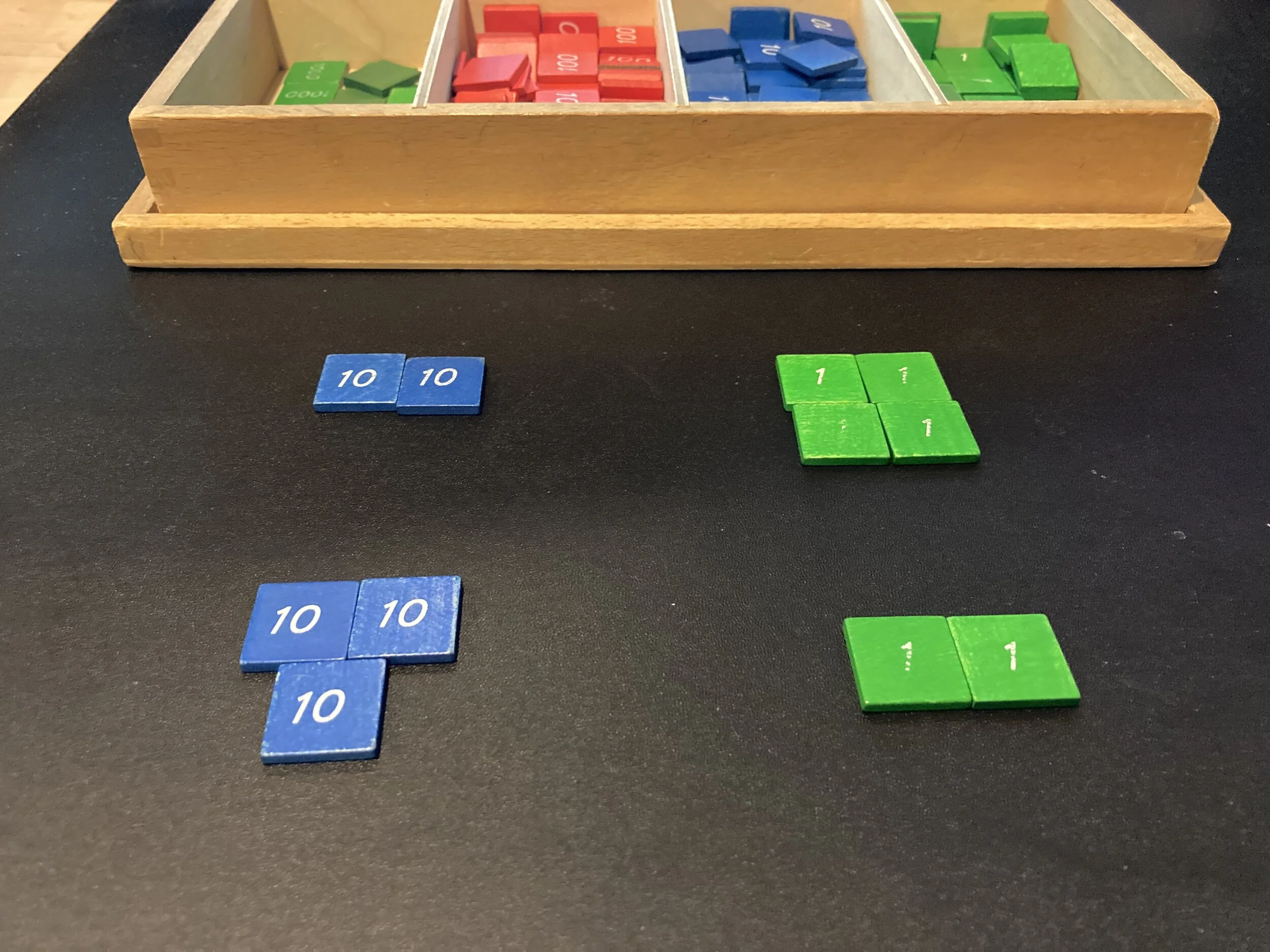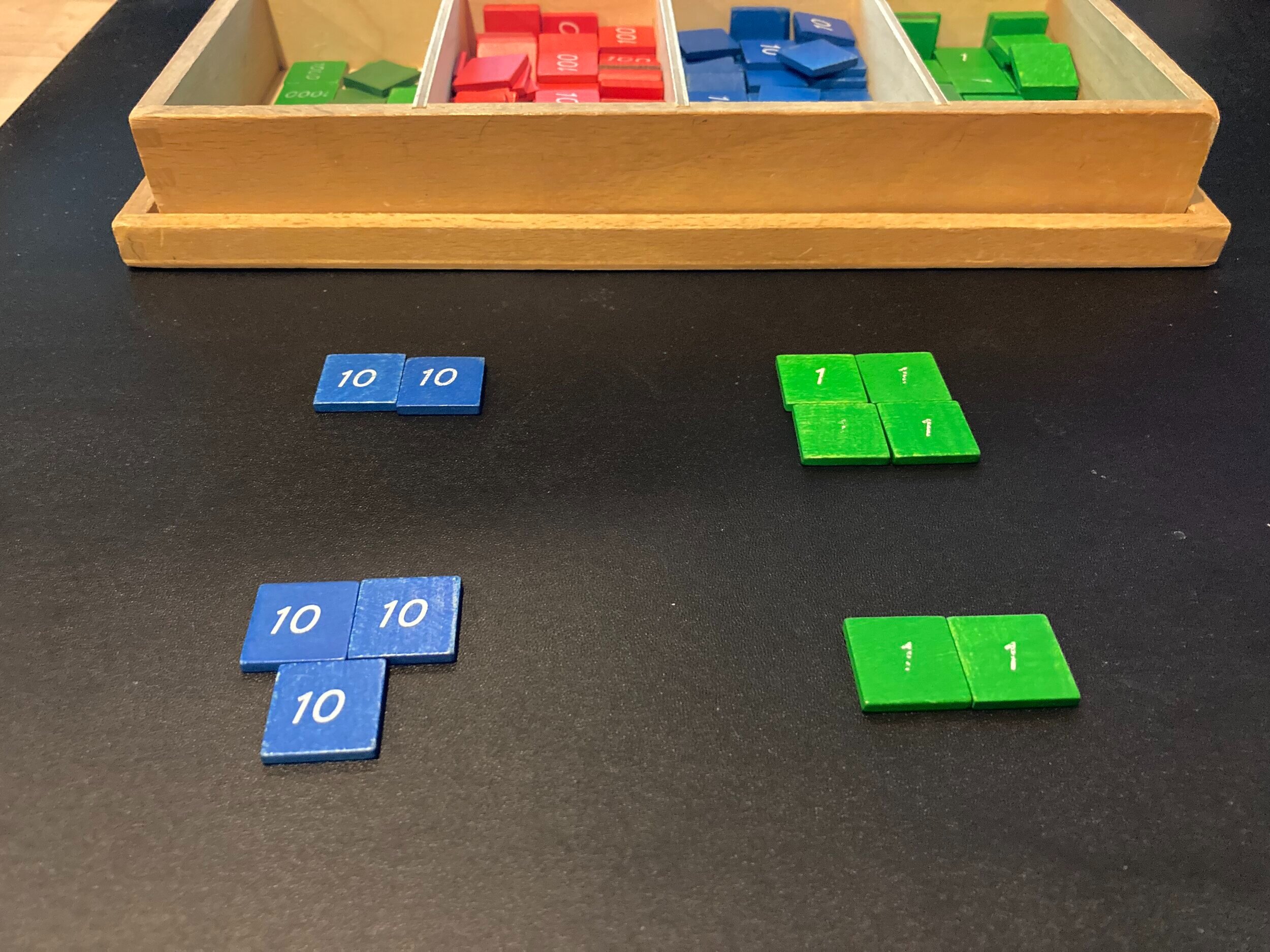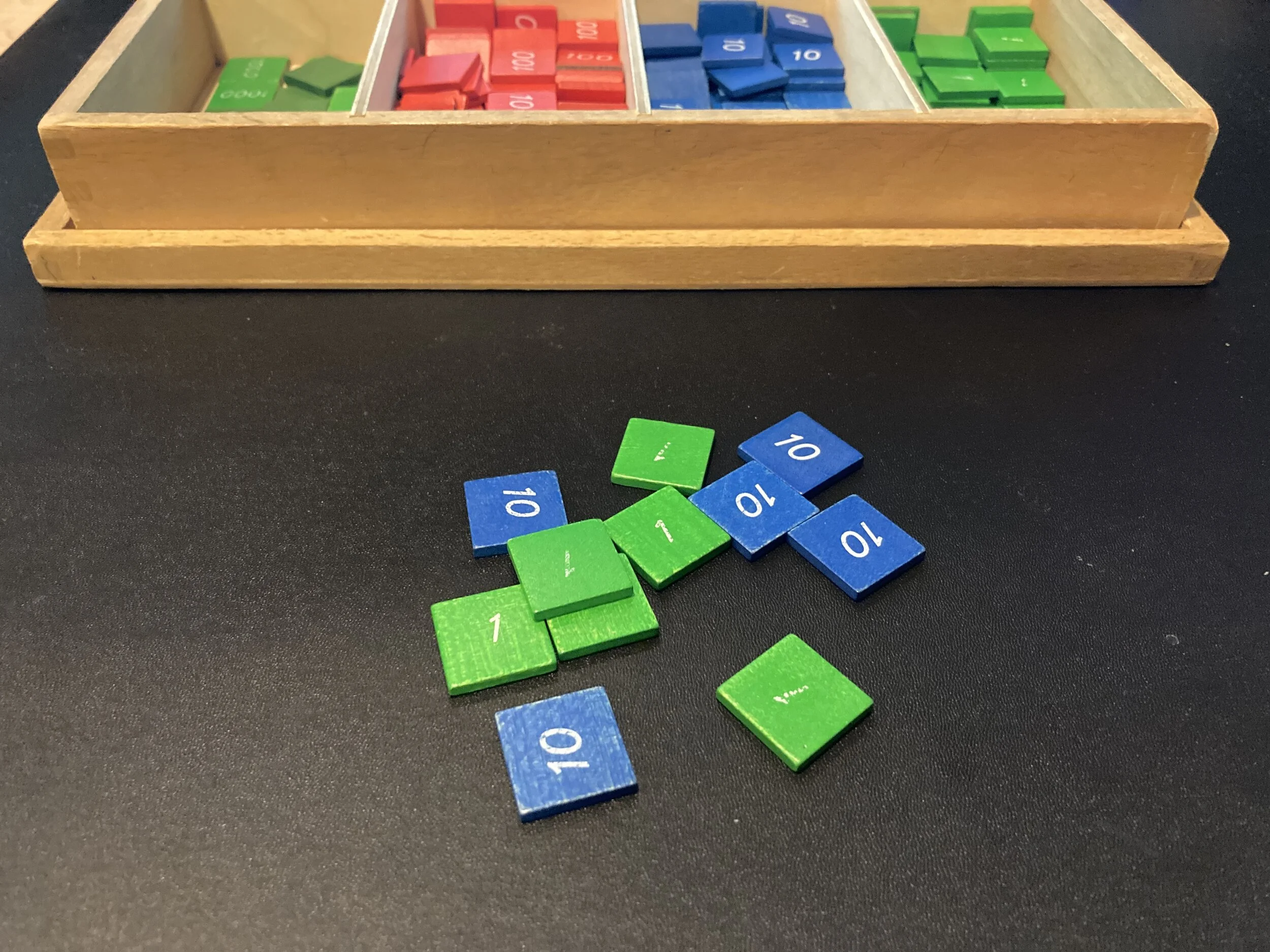This week, I had a fascinating discussion with some of my students that gave me remarkable insight into their understanding. I asked them to calculate 24 + 32. First, we calculated this using the usual stack and add method, which no one had any trouble with, and came up with 56. If that were the end of it, this would be a really boring blog post, but it's not. Earlier in my teaching career, I would have said "great, these children can do static addition," checked it off on my lesson list, and moved on.
This question was actually the beginning of a problem from the Illustrative Mathematics curriculum, and the point was not to find the correct answer, but to think of different ways of solving the problem. So instead of moving on, I asked the children to solve the problem a different way. I told them they could draw a picture, create a representation (they didn't know what this was, so note to self: give a lesson on mathematical "representations" before doing this lesson), use a material, or think of a way to solve it in their minds. Since I had asked them to bring their Stamp Games to the lesson, that was the obvious way to represent the problem, and that’s what they did.
When I asked them to show me what they’d done, some had come up with 56 (or something close to that) and others came up with 11! Now, here’s where my first instinct would have been to correct and give a review of how to do addition with the Stamp Game. Instead, I decided to ask the children to sort it out. This is approximately how the conversation went:
Me: “Hmmm…some of you say 56, and some of you say 11. It seems strange that 24 + 32 could be both 56 and 11, doesn’t it? How can we decide which one it is?”
Lola: “It doesn’t seem strange to me. I know some numbers can do that.”
Leanne: “It can’t be 11, because 24 and 32 are already bigger than 11.”
Kristin: “But when I counted the stamps, there were 11.”
Leanne: “But you have to count the tens and the units separately.”
Ahhh…now this is where things got interesting.
Me: “So let me see if I understand this. You both set up your addition problem with the Stamp Game like this:”
Setting up 24 + 56 with the Stamp Game
“But Kristin, you counted the stamps by squishing them all together and counting how many there are, and Leanne, you counted them by counting up all the blue stamps and then counting up all the green stamps. And then what did you do?”
Leanne: “There were 5 blue stamps and 6 green stamps and then you put the numbers together to get 56.” (In retrospect, I wish I had asked her why not 65, but I didn’t think of it. That’s a story for another day…)
Kristin: “But zero means nothing, so it doesn’t matter that there is a zero there. They are all the same, so you should just count them up.”
Leanne: “But it does matter. Ten isn’t the same as one.”
At this point, it was clear that we needed to approach the problem from a different angle, as none of the children had a way to break the deadlock. I would have liked to pull out the Golden Beads (decimal blocks in the rest of the education world), but they weren’t easily accessible, so I improvised by creating a story problem and drawing a picture, with a mental note to go back to the bead bars the next day.
Me: “Okay, let’s think about this a different way. We’re going to make up a story about this problem. Remember how Allie and Joan went apple picking the other day? Let’s imagine that Allie picked 24 apples and Joan picked 32. How many apples do they have for their applesauce? I’m going to draw a picture of this. Actually, we’re going to pretend they went to the dot farm and picked dots to make dotsauce, because I’m too lazy to draw that many apples.”
Allie and Joan’s visit to the dot farm
When the children looked at this drawing, they all came up with numbers around 56 (there were some counting errors, but they were minor).
By now, they were all pretty confident that the answer was 56, so I left them to think about why we should add the tens and the ones separately in the Stamp Game, with a plan to meet again the next day. That was also when I planned to pull out the Golden Beads and compare them with the Stamp Game. (I still couldn’t find my ten bars the next day—turned out they’d gotten pushed behind some books on my far-too-cramped shelves—so I made do with drawing them, which worked just fine.)
When they were satisfied, I showed them several different ways they could represent the problem: drawing a a picture, using Golden Beads (or drawing them), using the Stamp Game, and stacking and adding. In retrospect, I wish I had saved this for a different lesson. They were pretty done with this problem by then, and I don’t think they got much from my explanation.
What’s the Point?
I want to dig into this a little bit more. There were a few “teaching moves” I used here that I’ve picked up in readings from non-Montessori educators, but that I think are every bit as useful in a Montessori classroom.
We started with a very small problem, rather than one that used the full extent of the materials available. That was so the children would be able to really grapple with the quantities involved as concrete ideas, not simply as numbers and mathematical quantities, and so that they’d be able to find the result by counting-all (counting the 24 dots in the first basket and then continuing to count the 32 dots in the second) or counting-on (beginning with 24 and then counting the dots in the second basket).
From working with the Golden Beads, these children certainly know what 1000 “looks” and “feels” like, but I’m not sure they could readily imagine 1000 apples (or dots) in any meaningful way. They could draw 1000 apples, but I don’t think it would be a productive use of their time, and they’d spend so much time drawing and counting that they would lose track of what they were trying to figure out. (Maybe if we were trying to think of an efficient way to draw 1000 apples so we could check our work, but that’s a lesson for another day…)Once we solved the problem the “usual” way, using the standard American algorithm, which was simple for these children, we didn’t stop. In fact, the real lesson started after we knew the answer. The actual work was to think of as many different ways to solve the problem as possible. Although I didn’t introduce anything truly new, I don’t think most of them had thought much about the connections between the materials or between the materials and real life.
When a child came up with an absurd answer for the problem, after having already found the correct answer, I resisted (with difficulty!) the urge to correct or to re-present how to use the Stamp Game, which I would have done in the past. Instead of correcting this error, I did my best to stay neutral and ask the children to sort it out. My role was focused more on helping them clarify their arguments and framing the problem clearly.
This was a wonderful mistake! It was the sort of error that reveals there is something to learn, and it can be the start of a deep discussion. (Compare this to, say, making an error while using the standard algorithm, because you accidentally calculated that 4 + 2 = 7. For most children, this probably stemmed from a memory glitch or being in a hurry, not from any deep misunderstanding about how numbers work, making it a rather dull error.) It would have been a shame to cut off this productive conversation in favor of “teaching” the correct solution. In Becoming The Math Teacher You Wish You’d Had, Tracy Zager calls these sorts of mistakes “attempted connections” (p. 201ff), and I think that’s such an apt term. This child was attempting to make a connection between familiar counting and counting with tens and units, but it wasn’t quite the right connection.
All in all, I’m thrilled with how this conversation went. It didn’t go at all in the direction I had originally planned; I was intending to think of different ways to add these numbers mentally, i.e. doing 20 + 30 = 50 and then adding on the 2 and 4 to get 56, or doing 24 + 30 = 54, 54 + 2 = 56, but thinking this way of thinking was clearly not in their toolkits, so I will have to do some lessons on this. Instead, we dove into familiar materials, but it gave us such a great opportunity to wrestle directly with the nature of the decimal system, that I was perfectly happy to drop my plans in favor of what the children gave me.




